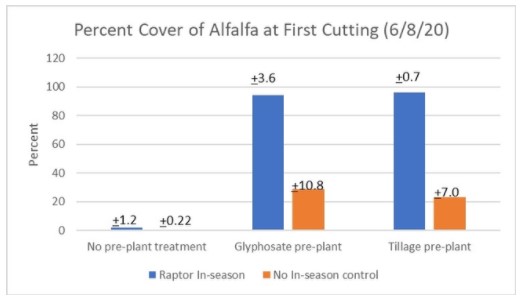By Sarah Light and Daniel H. Putnam
Good stand establishment is important for alfalfa production and can impact crop productivity not only in year one, but for many years. Stand establishment weed control is one of the most important factors for both conventional and organic growers.
Weed competition during stand establishment may be irreversible because it impedes root growth, results in thinner alfalfa stands, and can lower forage quality due to poor stands.
This project evaluated the efficacy of pre-plant weed control in alfalfa using mechanical cultivation or Glyphosate spray with the goal of providing both organic and conventional growers with regionally relevant information about an integrated weed management tool for improved stand establishment.
METHODS
Experimental Design:
Table 1. Experimental treatments
Six treatments (Table 1) were replicated three times in the field. Main plots were a pre-plant treatment (either no pre-plant treatment, pre-plant tillage, or pre-plant Glyphosate). Additionally, half of the plots received later in-season treatment (Table 1); either no treatment or Raptor application in-season after the crop had emerged.
This was a spring planting in the Sacramento Valley of California (note: we generally recommend an early fall planting, but spring plantings are feasible if done early). Weeds were germinated with winter rains. On some plots, Pre-plant Glyphosate was sprayed on plots on 1/31/20 at a rate of 3 pints Glyphosate/acre. On other plots, mechanical cultivation (tillage treatments) were implemented on 2/11/20, once the soil was dry enough. This cultivation was very shallow, in the top few inches of the soil, to avoid bringing new weed seeds to the soil surface.
Alfalfa seed was flown on the field on 3/4/20 and the field was then ring-rolled to cover seed and get good seed-to-soil contact. Field was then irrigated for germination a week later. In-season weeds were controlled on some of the plots with a tank mix of Raptor (Imazamox Ammonium Salt) at 6 fl oz per acre and Buctril (Bromoxnil) on 4/25/20.
Data Collected: Baseline weed counts were taken on 1/29/20 from all plots before treatment implementation but after weed germination. Individual broadleaf weeds and grasses + sedges were counted in three random 20x20 cm quadrats per plot. Plants were counted on this date because weeds and alfalfa plants were small and percent cover would not have captured potential differences.
Weed counts were taken an additional three times between planting and first cutting from all plots. In season weed counts were taken as percent cover, in which the area of the quadrat was broken up in percent covered with broadleaves, grasses + sedges, bare soil, and alfalfa. On 4/9/20 and 5/14/20, weed counts were taken in three random 20x20 cm quadrats per plot and on 6/8/20 percent cover was observed in 3 random square meter quadrats per plot. The larger quadrat was used for percent cover on 6/8/20 because alfalfa and weeds were tall at this time and the meter by meter square allowed for more accurate representation of each plot.
Plots were hand harvested on 6/8/20 prior to first cutting by the grower, which occurred on 6/10/20. Two square meter areas of each plot, which were representative of the larger plot, were cut. Yield biomass was separated into weeds and alfalfa, dried, weighed separately, and then converted to a pounds dry matter/acre basis.
Finally, on 6/23/20 following first cutting, alfalfa stand counts were taken in all plots by counting the number of alfalfa plants in three 20x20 cm quadrats.
RESULTS
Baseline and early weed counts. The first weed counts (1/29/20) collected before treatment implementation showed the average count for grasses + sedges for all plots was zero at this count. For broadleaves, there were no significant differences by treatment but there were significantly more weeds in the side of the field with no in-season control compared to the side where Raptor was applied in-season. 4/9/20 Weed Counts. Grasses + sedges: There were not many grasses or sedges in the field. Broadleaves: There were significantly less broadleaves in the plots that had pre-plant weed control (Glyphosate or tillage). Alfalfa: Alfalfa plants were small at this counting date however, there were significant treatment differences with the pre-plant weed control treatments having more alfalfa than the control. 5/14/20 Weed Counts. (Data not shown). Grasses + sedges: There were not many grasses or sedges in the field. Broadleaves: There were significantly less broadleaves in the plots that had pre-plant weed control (Glyphosate or tillage) and in the plots that had Raptor applied in-season. Alfalfa: There was significantly more alfalfa in the plots that had pre-plant weed control (Glyphosate or tillage) and in the plots that had an in-season herbicide.

Figure 1. Broadleaf Weed Cover at first harvest as affected by pre-plant and in-season weed control.
Broadleaf Weeds Dominated at first cutting (6/8/20). There were significantly more broadleaf weeds in the plots that had no pre-plant weed control (Glyphosate or tillage) (Figure 1). Additionally, the plots that had Raptor applied in-season reduced broadleaf weeds down to negligible levels compared with no in-season treatment (Figure 1). There were not many grasses or sedges in the field, however, there were more grasses in the side of the field with no in-season herbicide application.
